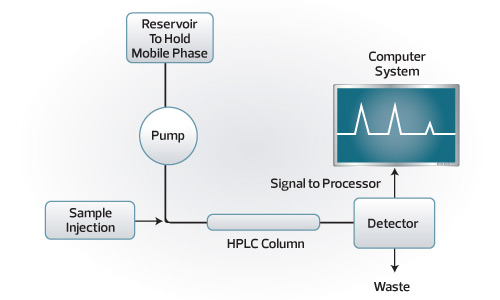HPLC Analysis and Testing
HPLC Analysis and Testing
ACTA Laboratories, Inc. is a cGMP FDA Registered Testing Laboratory that performs HPLC analyses on Pharmaceutical APIs (Active Pharmaceutical Ingredients) and Drug Products. ACTA can follow USP, BP, JP, and EP methods or develop methods of analysis for your API or Drug Product. ACTA can perform Method Validation and Verification to meet strict FDA regulatory requirements.
ACTA has the following detection capabilities:
- UV/Visible absorbance
- Photo Diode Array
- Refractive Index
- Conductivity
- Fluorescence
- Post-Column Derivatization
- Evaporative Light Scattering Detector (ELSD)
What is HPLC?
HPLC (High Pressure Liquid Chromatography), also know as LC (Liquid Chromatography) is a separation technique based on a solid Stationary Phase and a liquid Mobile Phase. Stationary Phase is the packing material contained in the HPLC column (hollow tube containing particles). Mobile Phase is the solvent or mixture of solvents (and sometimes other ingredients) that is passed through the HPLC column to flush the compounds through the column. Different compounds have different affinities that are attracted to the particles in the HPLC column and different affinities to being flushed through the column using the mobile phase. The competition between a compound’s affinity to stick to the stationary phase or get flushed away in the liquid mobile phase is what enables the separation. A mixture of different compounds can be separated by chromatography and then detected individually by a detector (e.g. UV Absorbance). The absorbance response for the separated compound will be proportional to the concentration of the compound in solution. Comparison of the detector response for an unknown to that of a known standard (known concentration of a pure compound) can determine the concentration present in the unknown. The analytes (compound you are testing the sample for) of interest must be dissolved in a solvent to perform an HPLC separation.
Components of an HPLC System (in order):
- Pump liquid pump that flushes Mobile Phase through the HPLC system
- Injector injects a small quantity of a sample or standard solution into mobile phase tubing
- Column a hollow tube filled with porous packing material (Stationary Phase)
- Detector instrument that monitors the fluid exiting the HPLC column and will respond to the compounds of interest in the analysis
- Computer System with Chromatography Software turns detector response into numerical result to determine concentration of each analysis
Schematic of an HPLC System

Please submit a completed form with your samples or send by email to info@actalabs.com
Download Here (48 kb)
Please include a completed form when submitting samples or send by email to info@actalabs.com
Download Here (953 kb)
